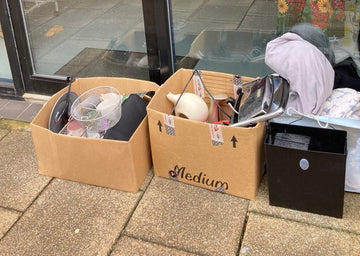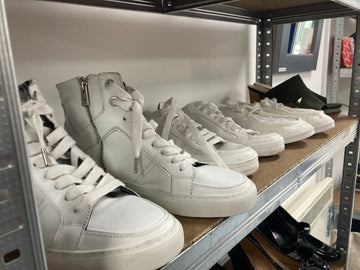A Potted History of Jeans and How to Make Denim Sustainable
My grandad owns a pair of vintage jeans that have as many patches on them as they have years of age! It is a testament to just how durable jeans are, and how we can make our clothes last a little bit longer with a bit of TLC.
Today's blog explores denim - where it came from, how it is made, as well as highlighting some of the brands that are making more sustainable denim as well as upcycling it.
A Potted History of Jeans and How to Make Denim Sustainable
How is Denim Made and why is Denim bad for the Environment?

Denim is traditionally made from cotton that is woven in a diagonal pattern. The well-loved blue colour is achieved by dyeing the cotton yarn with indigo. This is a process that takes several stages of washing and bleaching with detergents.
A pair of jeans takes around 8000 litres of water just in order to grow the cotton.
The washing and dyeing process only adds to this incredibly water intensive process. What's worse is that denim dye is even turning some of our world's rivers blue.
A report from Water Witness International (WWI) found that some of the rivers in Lesotho and southern Africa were so polluted they had turned blue from denim dye. Meanwhile other rivers were measured for their pH and the results were startling - the rivers were found to be as alkaline as bleach!
How old is Denim?
It is hard to think of a time before denim, today the denim market is worth $110bn globally, with 70 million pairs of jeans bought in the UK each year.
There's a couple of precursors to the modern pair of jeans.
A material called Serge de Nimes, which was a mixture of wool and silk has existed since the 17th century, coming from the city Nimes, in France. But a material called 'jean' can be traced back to 15th century Genoa - or Genes in French. What Serge de Nimes and jean have in common is the need for hard-wearing trousers for work.
Modern jeans as we know them are synonymous with Levi Strauss who patented the first pair of denim jeans. But in the murky depths of myth and history, there is a forgotten man who came to Levi for help.

Jacob Davis, a tailor from Nevada, designed the first pair of 'jeans' using copper rivets to strengthen the weak areas in the corners of pockets and in the crotch.
Davis needed to patent his work quickly, with other tailors copying his design after he started to sell more and more units.
He couldn't afford to protect his work with a patent or really expand his business to any real scale. This is where Davis goes to Levi Strauss, forging a business partnership that would become very profitable indeed. But these workwear trousers were still not known as jeans. They were called Levi's 'waist overalls', and would not be known as jeans until the 1960s. This is because, to start with, waist overalls were worn over the clothes of a miner or labourer.
A recent craze has seen people heading back down abandoned mines to find 'blue gold' in the form of old miner's jeans. It is another testament to their durability that the denim stays pretty intact, leading to some impressive finds, like this pair of miner's waist overalls from early 1900.
The Latest Denim Trends

On the topic of crazes, jeans are no exception when it comes to trends. We're now witnessing a baggier jean renaissance, saying goodbye to skinny jeans. When I recently visited a Levi's outlet in York, it was fascinating to see how the skinny section of racking was deserted, with the majority of customers browsing the bootcuts, straight legs and flares instead.
But give it a few years and the wheels of fashion will come back around and skinny jeans will be 'back in fashion'. Like most cycles of trendy clothes, this will lead to more demand for new jeans while the less fashionable jeans are pushed to the back of the wardrobe.
The way forward is to fall in love with jeans that we enjoy wearing the most, keeping a hold of them despite what styles are "IN" or "OUT". But if you still need to buy a new pair of jeans, there are some more sustainable ways to add to your collection.
Eco Friendly Denim Brands & Second-hand Jeans

The humble pair of blue jeans is constantly evolving. Recent Marie Claire sustainability award winner unspun has created a made-to-measure 3D scanning system to find that perfect fit. There is less waste thanks to creating jeans exactly the right size.
It is also worth going for jeans that use organic cotton, and a less water and chemical intensive washing process.
A few options include; Lucy & Yak, Pin Denim, Monkee Genes, People Tree or MUD Jeans.
Of course there is also the brilliant option of buying second-hand or preloved jeans! We love our jean wall in our Green Heart Showcase, and we also have a range of denim jackets. Browse our range of denim goods here.
If you ever find your pair of vintage jeans are showing their age a little too much, then consider getting them repaired, or even have a go yourself at some visible mending! Alternatively, there are a number of small businesses that take scrap denim and upcycle it into coats, bags, wallets and more. Look out for our next blog on denim featuring a few of these wonderful designs!
Further Reading on Denim
A Short History of Denim - a historian takes a look.
Levi Strauss - A Company Timeline - the story of the most influential denim brand
How jeans are made - a brief overview
Browse second-hand jeans for affordable prices - explore some good preloved denim brands.




